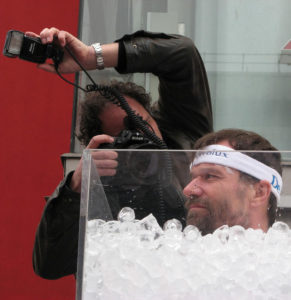
Wim Hof, aka the Iceman, defies the limits of human capacity.
He climbed the 5895m high Mount Kilimanjaro wearing only shorts & shoes.
He ran through the Namib desert in the same attire, without drinking any water.
In wintery fiords, he swam for a distance of 66 meters under the ice.
He sat for two hours in a container full of ice and warmed it up with his body temperature.
This man is a freak. Or is he?
The story, bio-logically commented
Wim Hof was a father to 4 children whom he could always inspire and cheer up, when his wife, who was suffering from depression, unsuspectedly died by suicide. Wim was left to raise the kids alone, and he was hugely distressed. It was then when he found respite in merciless nature; he was intuitively drawn to expose himself to the cold of a frozen lake. 1
“The cold silenced my mind. It brings you into connection with the deeper part of the brain, which is the adrenaline, the reptilian mode… which is not thinking but only feeling.
I didn’t feel the cold at all, but just power – which is connection.” 2
From Dr Hamer’s concept of biological laws and the brain-organ-social connections we learn that somatic sensation and suffering are suppressed in the “cerebellum constellation”. This means that when we are feeling under attack from all sides or on various levels, without means to protect ourselves, the brain’s inherent “pain-killer mechanism” is activated.
What Wim needed for the survival of his family was focus and invincibility – he used the power of his survival brain, the “Old Brain”, and learned to trigger it consciously by challenging himself with seemingly impossible feats.
Dr Hamer might have recognized the ultimate alpha male and leader in him: Wim Hof is not so much interested in ideologies but in the raw, true nature of things, and how to control and to use them for the benefit of his community – pacing and leading and empowering people all over the world.
Or might there still be a “postmortal constellation“ at play that evokes fearlessness and the devotion to something “bigger than oneself” when one has lost everything that matters?
Besides these speculations, Wim Hof seems to be a caring and humorous human being who likes to sing, joke and play the guitar.
Consequently, after 25 years of developing and using his method for himself, he felt it to be solid and ready to be studied and taught. It consists of 3 pillars:
- A breathing sequence that fills you with energy
- Challenges like cold exposure, breath holds, and proofs of balance and strength
- Commitment to mental training for focus and endurance
With the help of these techniques, Wim Hof and his trainees have demonstrated control over their organ reactions and immune system, to the extent that when they were injected with an endotoxin that would usually trigger definite symptoms like fever, inflammation and tiredness, they remained symptom-free.3
This is great news in the context of META-Health, as we understand that the same symptoms (and more) can be caused by social conflicts, where they often appear in the phase of regeneration after addressing and resolving that conflict. It is during this phase where a learning step is processed and integrated by our mind and organism; and this integration process can take its time and toll on our system. Empirical evidence tells us that pains and problems during this phase often lead to sequels and self-devaluation in the concerned person, which interferes with the healing process.
To remain in gratitude in the present, and to prevent hyperalertness and hypersensitivity in the future, we need faith and self-esteem – and these can efficiently be developed with the Wim Hof method (WHM), to the extent that we might not need to experience those typical symptoms at all while regenerating!
It also offers massive hope and relief to people who, according to Dr Hamer’s concept, would fear to resolve long-standing conflicts because that might lead to dramatic or unmanageable symptoms such as heart attacks in the “healing peak”.
The science: what’s happening in the body?
This study 4 has been conducted to find what changes in brain and organ tissue are accomplished by the WHM:
- The FMRI scan taken while Wim was in the ice-bath shows a drop in activity in parts of the insula. In META-Health these refer to the coronaries, laryngeal and bronchial territorial areas, meaning that stress-reactions from social settings connected to love, power and fear are deactivated. Conventional science finds these areas to be “uniquely associated with self-reflection, and which facilitate both internal focus and sustained attention in the presence of averse (e.g. cold) external stimuli.” This means resilience in conflictive situations…
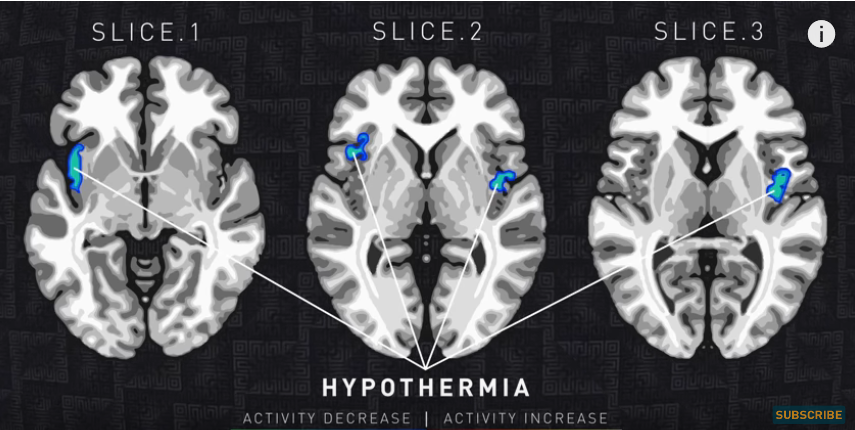
Reference: “Brain over Body” Michigan Study -
Simultaneously, emphasized activity was noted in the periaqueductal grey area in the midbrain, referring to pain modulation (like the “cerebellum constellation” – the brain’s inherent “pain-killer mechanism” mentioned above) and smooth muscle activity, which could be interpreted as reactions in arterial muscle or in the fascia of the breathing muscles.
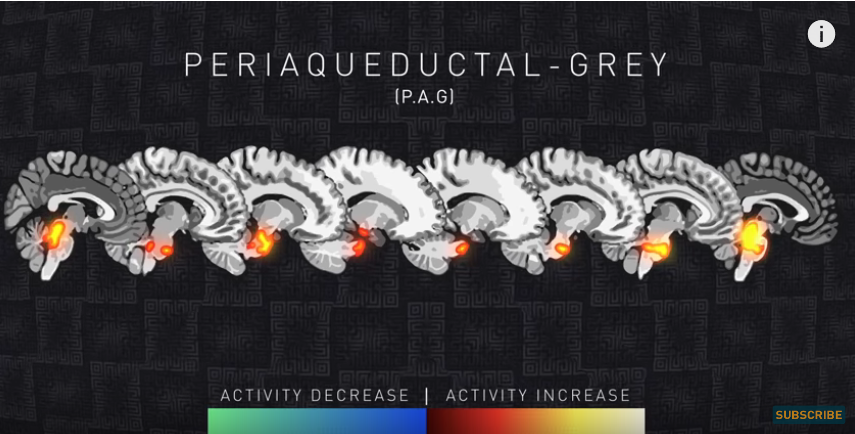
Reference: “Brain over Body” Michigan Study - Forceful respiration (as well as the urge to breathe at the end of breath holds) results in increased sympathetic – mobilizing – innervation and the release of adrenaline. This matches the active phase of stress management by the adrenal medulla, but Wim does it here at will, and without conflict. To be able to do this is of great help in reframing anxiety rssponses, differentiating excitement from helplessness.
-
 Glucose consumption rises in the intercostal muscles, generating heat that dissipates to the lung tissue and warms circulating blood in the pulmonary capillaries, to protect the lungs and heart. Both-sided activation, just like in conflicts of self-devaluation regarding breath and protection of the inner space, creates self-motivation, the feeling of power and invincibility which has been called “megalomania”. Connected to this, the release of opioids and endocannabinoids 5 could be noted, comparable to a “runner’s high” under profuse exertion.
Glucose consumption rises in the intercostal muscles, generating heat that dissipates to the lung tissue and warms circulating blood in the pulmonary capillaries, to protect the lungs and heart. Both-sided activation, just like in conflicts of self-devaluation regarding breath and protection of the inner space, creates self-motivation, the feeling of power and invincibility which has been called “megalomania”. Connected to this, the release of opioids and endocannabinoids 5 could be noted, comparable to a “runner’s high” under profuse exertion. - In analysing the immune responses in Wim Hof and his trainees upon being injected with e-coli bacteria, fewer pro-inflammatory cytokines and more anti-inflammatory cytokines were found in their blood, compared to the control group. Cytokines are the regulators of our body’s immune responses under stress and regeneration.
- In studying the extremely low incident rate of mountain sickness (hypoxia) in trainees of the WHM who climbed Mt. Kilimanjaro in just 2 days, the breathing method obviously develops skills that are useful for athletes and prevents activation of lung tissues like goblet cells and alveoli through conflicts of suffocation and the fear of dying (due to lack of air). 6
Now: Let’s breathe!
Here are the steps of the breathing sequence, which resemble “Tummo” in Yogic exercises:
Caution: Always do this well-sustained, either lying down or sitting, and never when attention is needed elsewhere! Never do this when submerged in water!
- Power breathing: Take 30 forced in-breaths – direct the air into all body parts and then release only the excess, so no deep exhale here. This “willful hyperventilation” can trigger symptoms of hypocapnia like tingling sensations and lightheadedness. Enjoy the experience!
- Breath hold: Then breathe out and stop breathing for as long as you can. Direct the energy to the places you want to heal and to enhance. This breath pause may take several minutes!
- Break: When you feel the acute need to inhale – usually after some contractions of your diaphragm – take a deep breath and keep it in for 10 seconds.
- Repeat this sequence 1-3 times.
- Alternative: during the breath hold you can do push-ups or other feats to test your power.
Let’s face the cold!
Cold exposure stimulates the (immobilizing) vagus nerve, and it also increases the release of endocannabinoids, both of which support calm, relaxation and regeneration. In conjunction with the breathing exercise, this serves to make you less “manic” and better grounded.
Do all exercises with cold exposure gradually and willfully! Never do the breathing while submerged!
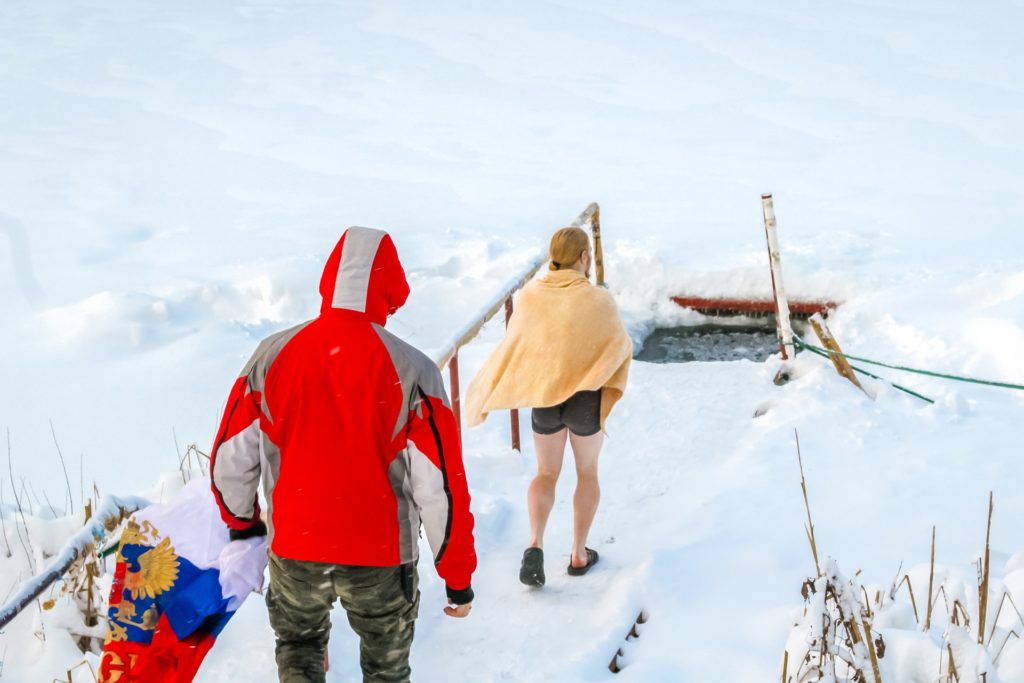
- If needed, warm yourself up with breathing or exercising
- Focus on a source of warmth within you.
- Begin with cold showers or even moderate showers, from the extremities up to belly, chest and head.
- Always end warm showers with turning the tap to cold!
- Lengthen the time of cold exposure until you reach several minutes.
- Try “really cold” temperatures such as a mountain stream, a pool with ice added, or a wintery lake…
Commit yourself!
You do that already when trying out and challenging yourself with these experiences. To reap the benefits, you want to create new habits! Remember the SMART milestones to reach your goals? Use them!
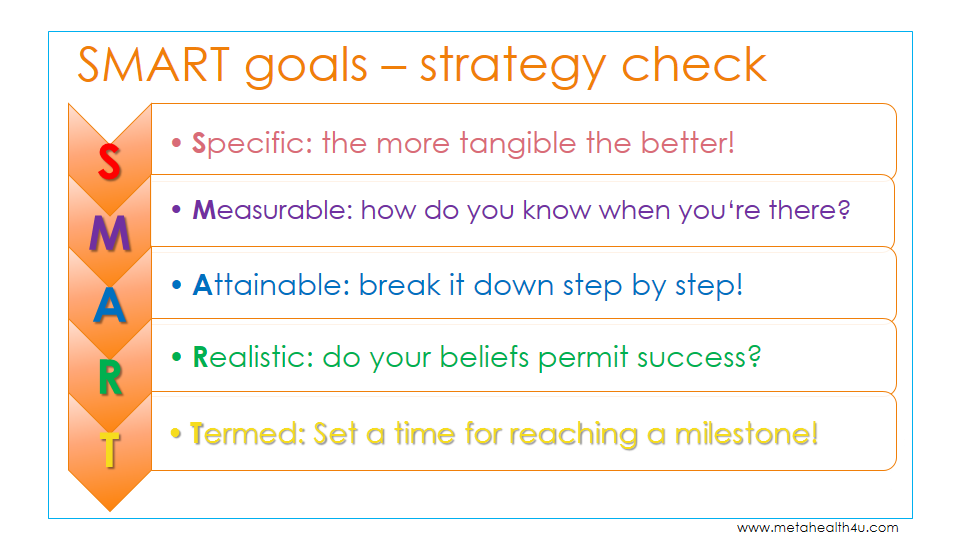
Conclusion
The WHM is a biological “pattern interrupt” and a convincer. The breathing sequence is not a breath training to adopt throughout your whole day in order to optimize oxygenation, but a conscious switch to the sympathetic (energized) state while staying mindful and relaxed. It is essential, in order to enhance resilience, to make use of accessing these energetic resources for to challenge yourself out of your comfort zone!
The WHM may not be suitable for everyone. Try it yourself – if you feel excited by your response, explore it further! People who suffered from asthma, COPD, addiction, depression, arthritis, fibromyalgia, chronic Lyme disease and other dis-eases have testified they benefit from it. (Note that these diseases are basically connected to the “social brain” with territorial and self-devaluation conflicts in the background!)
If you feel overwhelmed, feel free to experiment with parts of it. If you feel it’s not your style, great! The META-Health methodology will lead you to discover what’s better for you at this point.
* “Postmortal Constellation”: when two conflict themes – “loss of love” and “loss of territory” – have shaped one’s personality to be interested in death or things beyond death. This may involve fearless dedication to a higher goal, but also manic, depressive, or suicidal behaviour.
This article was first published in the META-Health 4 U blog
Sources:
[1] https://www.youtube.com/watch?v=R_fqcruPL30
[2] https://www.youtube.com/watch?v=H__Z_8RIPtA
[3] https://www.ncbi.nlm.nih.gov/pubmed/24799686
[4] https://www.sciencedirect.com/science/article/abs/pii/S1053811918300673
[5] http://www.jlr.org/content/57/3/464.short
[6] https://www.youtube.com/watch?v=D6EPuUdIC1E
Pictures:
[1] Aad Villerius from OudBeijerland, Netherlands via Wikimedia Commons [CC BY-SA 2.0]
[2] [3] Brain pictures screenshots from the video https://www.youtube.com/watch?v=YficBlvPwWQ
[4] Pete Linforth via Pixabay [Pixabay license]
[5] photochur via Pixabay [Pixabay license]
[6] Kora Klapp
 META-Healthy Life articles are created by professionals and friends of META-Health International CIC, supporting individual and global health by deepening and sharing our understanding of how resilience and well-being are achieved.
META-Healthy Life articles are created by professionals and friends of META-Health International CIC, supporting individual and global health by deepening and sharing our understanding of how resilience and well-being are achieved.